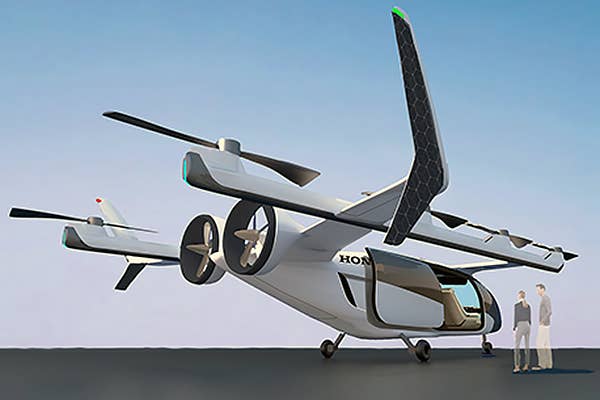
Honda’s new electric vertical takeoff and landing (eVTOL) aircraft will feature decentralized propulsion and multiple small rotors to ensure quiet transport for urban environments. Honda
Honda has announced its entrance into the electric vertical takeoff and landing (eVTOL) market as part of its new “mobility ecosystem.”
Honda’s new aircraft is committed to clean operation through the use of gas turbine hybrid power units, with an estimated range of 249 miles, the company said Thursday. The proposed aircraft will feature decentralized propulsion and multiple small rotors to ensure quiet transport for urban environments.
The Japan-based company is the latest player in a quickly growing industry aimed at building small, environmentally friendly passenger aircraft for short hops over congested traffic on the ground.
Honda is developing the eVTOL within a larger, unified plan for a “mobility ecosystem,” which would include ground transport, air transport, and a reservation service system. Honda imagines it would be used by travelers to reserve autonomous road travel to a Honda vertiport, followed by air travel via their fixed-winged eVTOL, and then an autonomous car would carry them on the final leg of their journey.
The ecosystem would offer passengers the option to change routes in mid-flight to avoid traffic delays.
“Ever since the company’s founding, the wellspring of Honda’s challenges has always been the people at Honda who generate original technologies and ideas,” Keiji Ohtsu, president of Honda R&D, said. “Through the creation of new mobility, Honda will continue striving to change the value people place on mobility and make positive changes to our society.”
Honda now joins Hyundai and Toyota as car makers entering the eVTOL business. They’ve recently announced efforts to vitalize the air taxi market. Toyota has partnered with Joby Aviation to develop its breakthrough eVTOL aircraft.
Other Honda News
In addition to a multifingered “Avatar Robot,” Honda also announced it will be developing a circulative renewable energy system to use on the moon alongside remotely controlled robots.
“Honda is conducting a joint research with the Japan Aerospace Exploration Agency (JAXA) with a goal to build the circulative renewable energy system on the lunar surface by leveraging fuel cell technologies and high differential pressure water electrolysis technologies Honda has amassed to date,” the company said in their statement.
As part of its lunar endeavors, Honda is developing small reusable rockets to place small satellites in low-earth orbit.

Sign-up for newsletters & special offers!
Get the latest FLYING stories & special offers delivered directly to your inbox






